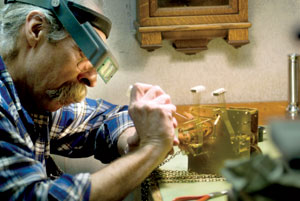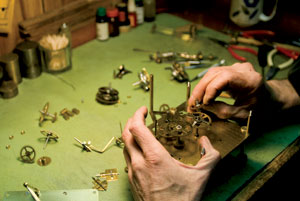If anybody has the power to turn back time, it’s Ed Clum. But with some things, there is no going back. Traditions fade and the world moves on. Not even a skilled clockmaker like Clum can stop the gradual disappearance of his ancient trade.
When Clum looks around Montana, he sees a lot of retiring clockmakers but not many younger folks lining up to replace them. Clum, owner of Glacier Precision Clockworks, has been in the clock business “longer than I can remember,” including 19 years in his downtown Kalispell location. The job has always been solitary, but now the industry is lonely too.
“I don’t know what it is, but they’re dying fast,” Clum said. “It’s happening everywhere. The old timers are dying out and I don’t know what’s going to happen now.”
Clockmakers and watchmakers practice horology, broadly defined as the art and science of measuring time and specifically defined, in the professional sense, as the field of repairing and making timepieces.
Dave Berghold, who has owned The Last Wind-Up in Bozeman since 1990, said he recently researched Montana’s watchmaking history for an article he wrote in a history publication. When the railroad emerged in the late 1800s, Berghold said nearly every town along the tracks had a watchmaker.
But by the middle of the 1900s, and especially by the 60s and 70s, Berghold said the quartz watch revolution had taken over.
“Watchmakers were saying, ‘We’re just going to be replacing batteries,’” Berghold said. “That was true to an extent and it remained that way for a good number of years.”
In the 1980s, however, the collectible watch market gained popularity. Suddenly, notable Swiss watch manufacturers were releasing “obscure and very complicated” old-school watches, Berghold said.
 |
|
Ed Clum adds tiny drops of lubricant to points on the inner mechanics of a clock at his business, Glacier Precision Clockworks, in Kalispell. |
“The collectible watches just went hog wild,” he said. “The market has gone kind of crazy.”
He added: “To some degree, clocks followed the same trend.”
A supply and demand dilemma has arisen from the modern popularity of collectible timepieces. There are a lot of old watches and clocks out there, but increasingly there are fewer professionals to service the often complex timepieces. Berghold estimates there are 50-55 working clockmakers and watchmakers in Montana. A lot of them, like Clum, are busier than they can handle.
Clum no longer repairs watches nor does he advertise. His numerous clock customers keep his schedule packed. Clum, a certified horologist, works on all kinds of clocks. His shop on First Avenue East is littered with myriad tools of varying sizes. He makes his own parts with lathes and mills. He performs house calls on large clocks by request.
Berghold stays similarly busy, though he only works on watches today. Back when he did clocks as well, he had a backlog of two to three years.
So this fact remains: Cherished collectibles will always be around, even if the experts to service them aren’t. Clum has worked on clocks from the 1600s and 1700s. If they’ve stuck around this long, you’d have to think they’ll persist for another couple of centuries. These timepieces generally mean something important to their owners, even, or maybe especially, in this digital age.
When Berghold stepped down as president of the National Association of Watch and Clock Collectors Montana chapter, he left his members with one final message. He asked them to get nonmembers interested in their trade. By creating enthusiasm in the craft, Berghold hopes to nurture an emerging generation of horologists.
Part of the challenge, he said, is simply the world we live in today. So much is digital and disposable that kids feel no connection to the processes that make everything work. They just press a button.
“Kids today don’t have a great exposure to mechanics – gears, sprockets,” Berghold said. “Everything is more or less – not to be jaded – disposable. Fixing stuff is not in our capacity as much as it used to be.”
Maybe Berghold’s plea is being heard. He has hired an employee who is the first 21st-century certified watchmaker in Montana. The certification, through the American Watchmakers-Clockmakers Institute, allows The Last Wind-Up to keep its Rolex parts account. Manufacturers like Rolex require specifications certifications today, Berghold said.
Another newcomer to the field is Janet McGrath, who opened up McGrath Time & Chime in Kalispell three-and-a-half years ago. After a career in software development, McGrath sought a profession that could carry her into retirement. She visited the National Watch and Clock Museum in Columbus, Pa., and became enamored with horology.
 |
|
Ed Clum works on reassembling the inner workings of a clock at his Kalispell repair shop Glacier Precision Clockworks. |
McGrath then completed courses at the National Association of Watch and Clock Collectors School of Horology and opened up her business.
“It’s a fascinating field,” she said.
But these up-and-coming horologists are few and far between, in Montana and elsewhere. Clum has seen quite a few “come and go.” The job isn’t for everyone. Clum spends most of his days alone in his shop, solving endless mechanical puzzles, as dozens of clocks around him rhythmically tick away the hours.
“Some of these clocks haven’t run for 100 years and I get a call to fix them,” Clum said. “That’s pretty satisfying – to make something run that hasn’t worked for that long.”
“You’ll never make 100 grand or $150,000 in this job,” he added. “It’s more about love than anything. That’s the whole thing. I love what I do.”